Please note since the publication of this review in June 2017, nPAE have reduced the price of the turret to £995. I have been informed that no changes have been made to the design.
I have a scattergun approach to astronomical observing. Jumping from one object to another in quick succession (I really should take up sketching to force myself to slow down), one moment it might be high powered views of a planet, before switching to low power views of a large open cluster, quickly moving onto a medium power view of an emission nebula before back to a high-powered view of a small planetary nebula. It has been that way for more than a quarter of century and it is unlikely to change any time soon. The consequence of this is I change eyepieces rather frequently. Fiddling around in my eyepiece case, I lose time observing, which is somewhat of a valuable commodity in the almost omnipresent grey UK. However, the bigger risks come from a slip and gravity taking hold of a valuable eyepiece which can be catastrophic, or in my case, up until now at least, an errant thumb leaving a print on the eye lens.
One obvious solution for those of us who are forever switching eyepieces is the use of a turret. A number of models have been available over the years including the Baader Q Turret at the low end to some very good models from Takahashi and TEC in the midrange all offering 1.25” eyepiece compatibility. Until a devastating wild fire in Colorado in 2013 which destroyed their workshop, Van Slyke Engineering offered a high-end turret offering 2” eyepiece (and 1.25” with adaptors) functionality but since then, those of us who enjoy the majestic wide fields offered by 2” EPs have found ourselves restricted to standard mirror diagonals and switching out eyepieces. Now a new British based company called nPAE (short for Nottingham Precision Astro Engineering) have launched their first product into the marketplace, the 6061 Medium Eyepiece Turret, offering both 1.25” and 2” eyepiece locks at £1,995.00.
A chance meeting in Maplin saw the formation of nPAE. Nick who has a background in space and engineering was working a short stint in the shop when Dave walked in to purchase a memory card for his 40th birthday. A conversation was struck over a shared passion for astronomy and with Dave having thought about starting a business after a long career in the City and Nick wanting to put his engineering and design talents to good use saw the genesis of nPAE. The 6061 Medium Eyepiece Turret has been in development for over two years.
Those of you who attended the February 2017 Astrofest in London most likely came across nPAE demonstrating their new turret on the top floor of the exhibition. Nick and Dave were kind enough to loan me a unit for testing at the end of the show and I have been putting it through its paces during the last months of winter and spring.
First Impressions
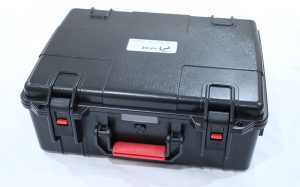
The Cerberus Hard Case keeps the turret safe when not in use, but could also be a good choice for a small scope & accessories for a travelling astronomer. Click for larger image.
The current batch of the 6061 Turrets are shipped in a nPAE Cerberus hard case. The team seem rather proud of these cases and just how robust they are as Nick (who stands over 6 feet tall) demonstrated to me at Astrofest by standing on the case and then jumping up and down on it. Available to purchase on a standalone basis for £95, the ingress protection rating is IP67 meaning it is protected from total dust ingress and protected from immersion in water to depths of 1 metre. The IK-08 impact rating implies protection for the internal equipment equivalent to 1.7kg mass dropped from a height of 300mm, though the jumping demonstration would seem to indicate it is up to more than that. As would be expected in a case of this quality it comes with external lock holes and a pressure release valve for flying. With internal dimensions (including lid cavity) of 43.5cmx31.5cmx17cm (external max of 46cmx38cmx18.5cm) and a 60kg carrying capacity, the Cerberus Case would be an excellent choice for an eyepiece case or as a travel case for a small 6-8cm aperture scope and accessories for trips to dark distant lands as those dimensions comply with the most restrictive of hand baggage allowances. The cases are supplied with pick-and-pluck square cut foam so you can create your own arrangement internally and an egg-box shaped foam insert for the lid.
The first impressions of the 6061 Turret do not disappoint, appearing to be a very serious piece of engineering and wonderfully finished with red anodising which provides additional resistance corrosion and wear, an important consideration for the rather damp UK. The turret itself is CNC-milled from solid blocks of aircraft grade 6061 aluminium to minimise weight and provide maximum rigidity. However, this is still a heavy piece of equipment at 2,412g (5.32lbs) including a 2” filter holder. Combined with half a dozen eyepieces of varying sizes will mean most telescope owners need to give consideration to balance issues as well as the quality of their focuser. Using custom designed “Maia” compression fittings, each turret is equipped for three 2” eyepieces and three 1.25” eyepieces.
The engineering quality is also found below the surface where rare-earth magnets are used to hold the turret in place and a large Teflon bearing ensures smooth rotation of the turret as well unit longevity. At the centre of the turret is a BK7 1/10th wave elliptical mirror.
The internals of the turret are painted flat black to cut down on scattered light from off axis rays which degrade contrast at the eyepiece. However, unlike the Tele Vue Everbright diagonal there is no internal baffling with knurled surface on the nosepiece. Using an off-axis light source there was a modest amount more internal scattered light seen in the turret when compared to the TV diagonal, but in use I was unable to detect any appreciable difference in contrast at the eyepiece.
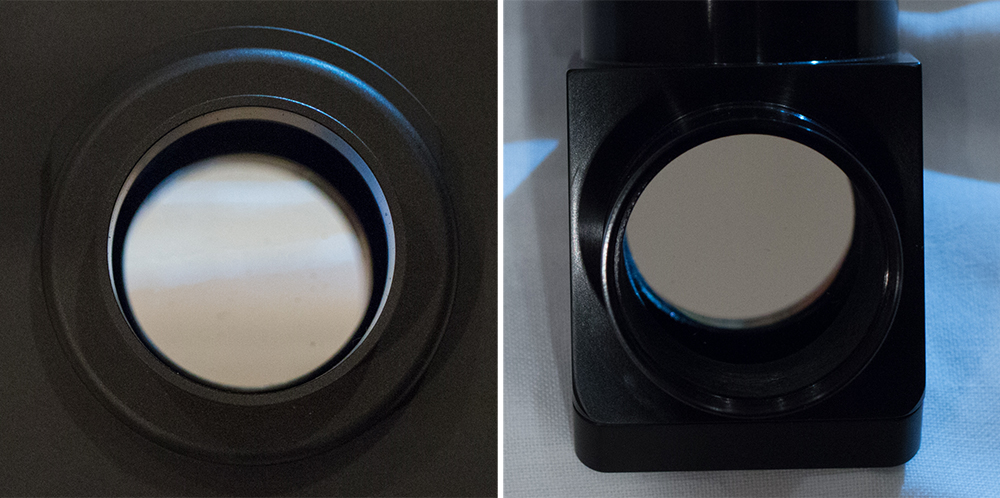
Using a bright off-axis light source, the 6061 (left) and Televue Everbright 2″ diagonal were compared for stray light suppression. Image is of the nosepiece.
The nPAE designed Maia locks are quite easy to use and certainly grip firmly, something that is rather important when hanging a £600 eyepiece upside down. Each operates a compression fitting with a modest rotation of the lock, no more than 1/32 to 1/16 of a full rotation. There is a small thumbscrew which is then twisted to lock the compression fitting down. Each Maia lock is rated to hold up to 1kg, though I have used slightly heavier equipment with no issue. When I first tried setting up the turret, I was not convinced that I was using the lock correctly as the rotation was so slight, however, viewing an instruction video online demonstrated that the rotational movement is very limited. I do find the thumbscrews a little bit fiddly, especially when wearing gloves, but typically once the turret is set up, there is no need to make any adjustments during an observing session.
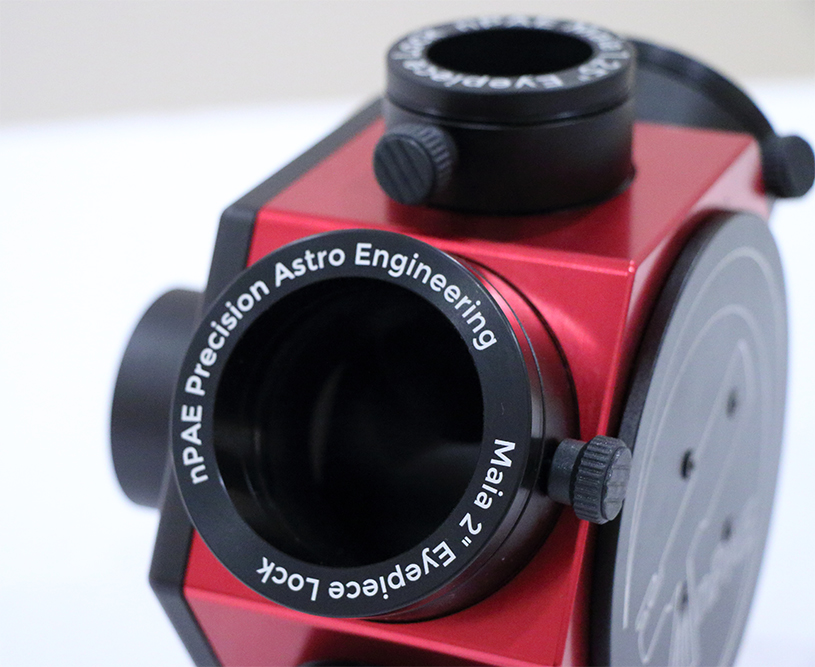
The Maia locks employ a two stage process to secure eyepieces and other equipment such as cameras and spectrometers.
Additionally, each lock benefits from a focus wheel which has 10mm of travel allowing all accessories to be brought to the same focal plane, thus eliminating the need to refocus when switching eyepieces.
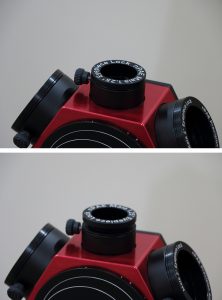
Each Maia lock as a parfocal adaptor with 10mm travel allowing a variety of EPs to be brought to a simultaneous focus.
One slightly surprising omission from the turret design is there is no internal mechanical stops inside the Maia locks to prevent any accessories which have a long shaft, such as some barlows from striking the diagonal mirror. The depth to the top of the mirror is approximately 6cm so some care should be taken when inserting any long-body equipment. Based on my feedback, nPAE informed me the design has been modified to include a mechanical stop inside each Maia lock going forward.
I measured the optical path length of the turret to be 151mm so keep in mind that a reasonable amount of back focus is required to use it. For reference the 2” Tele Vue Everbright was measured as 102mm.
Looking somewhat like a captain’s wheel from a ship when 6 eyepieces are locked in place, I was very impressed with the smoothness of the demonstration model at Astrofest, though my test model felt a little tight when I first used it. However, after inserting eyepieces into each Maia lock, the movement was just as smooth as the demonstration unit. Should you wish to adjust the resistance to movement, there are four 2mm hex-screws in the front plate which allow for user adjustment. Removal of these four screws will release the plate with the nPAE logo providing access to the diagonal mirror should it ever need to be cleaned.
While the rotational movement is very smooth, one aspect of the turret did not conform to my initial pre-use expectations. I had anticipated that with each 60-degree rotation that the unit would “click” into place giving a sense that the newly selected eyepiece was exactly parallel to the optical axis. However, with the 6061 turret, while the unit clearly pulls each of the hexagonal sides to position, it seems to settle into position rather than snapping into place. This left me wondering whether the alignment was precise enough not to noticeably shift the on-axis sweet spot of the telescope and potentially introduce imaging degrading aberrations such as coma into the view.
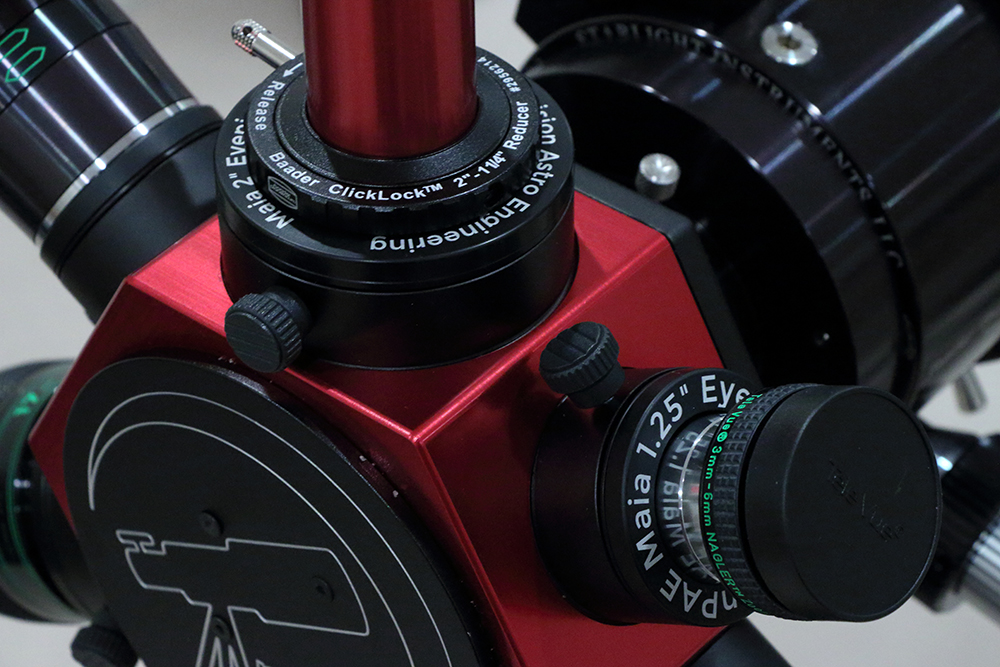
To confirm alignment was precise at each position, a Cheshire was used and the reflection patterns recorded. Eyepieces were installed in all other Maia locks to simulate real world conditions.
Bench Testing
No rotating mechanism will ever match the exact precision of a fixed star diagonal, but if designed appropriately and machined to high tolerance, any deviation should be unnoticeable during normal use. To test the 6061, I used two Cheshire eyepieces (to eliminate potential fabrication issues in the Cheshire) as well as a collimated self-centring laser and finally performed several star tests against a diagonal mirror of known quality to identify any issues. I used my APM LZOS 180 triplet refractor for these tests. Not only does it boast the most impressive focuser I have ever used, a 3.5” Starlight Instruments Feathertouch, which should eliminate any flex in the optical train, but also the scope has not been used since APM re-collimated it for me and is in perfect alignment.
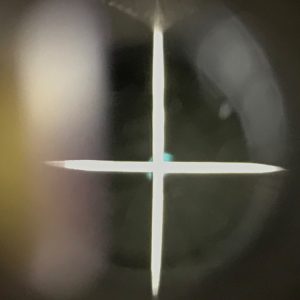
The Televue Everbright. Taken using a camera phone through the sight hole of a Cheshire, the reflection pattern is on the optical axis.
First checking the alignment of the scope straight through, the pattern of dim concentric circles seen in the sight hole was exactly as expected. I took the opportunity to test my Tele Vue 2” Everbright diagonal which was used as the reference standard during testing. The introduction of the diagonal made no observable difference to the reflection pattern seen. To approximate real world conditions, eyepieces were secured in each of the unused Maia locks when using the Cheshire. To allow testing of the 2” locks with the Cheshire, a 2” to 1.25” Baader Click Lock adaptor was used.
As can be seen in the accompanying image, the turret alignment is quite precise at each position with very minor deviation to the right seen a few times and a small vertical offset from centre. I have personally used fixed star-diagonals which have deviated more than this with no noticeable impact seen at the eyepiece.
To confirm the results using the Cheshire, I also used a self-centring laser, measuring where the laser emerged through the objective lens. There was no discernible deviation from the on-axis position.
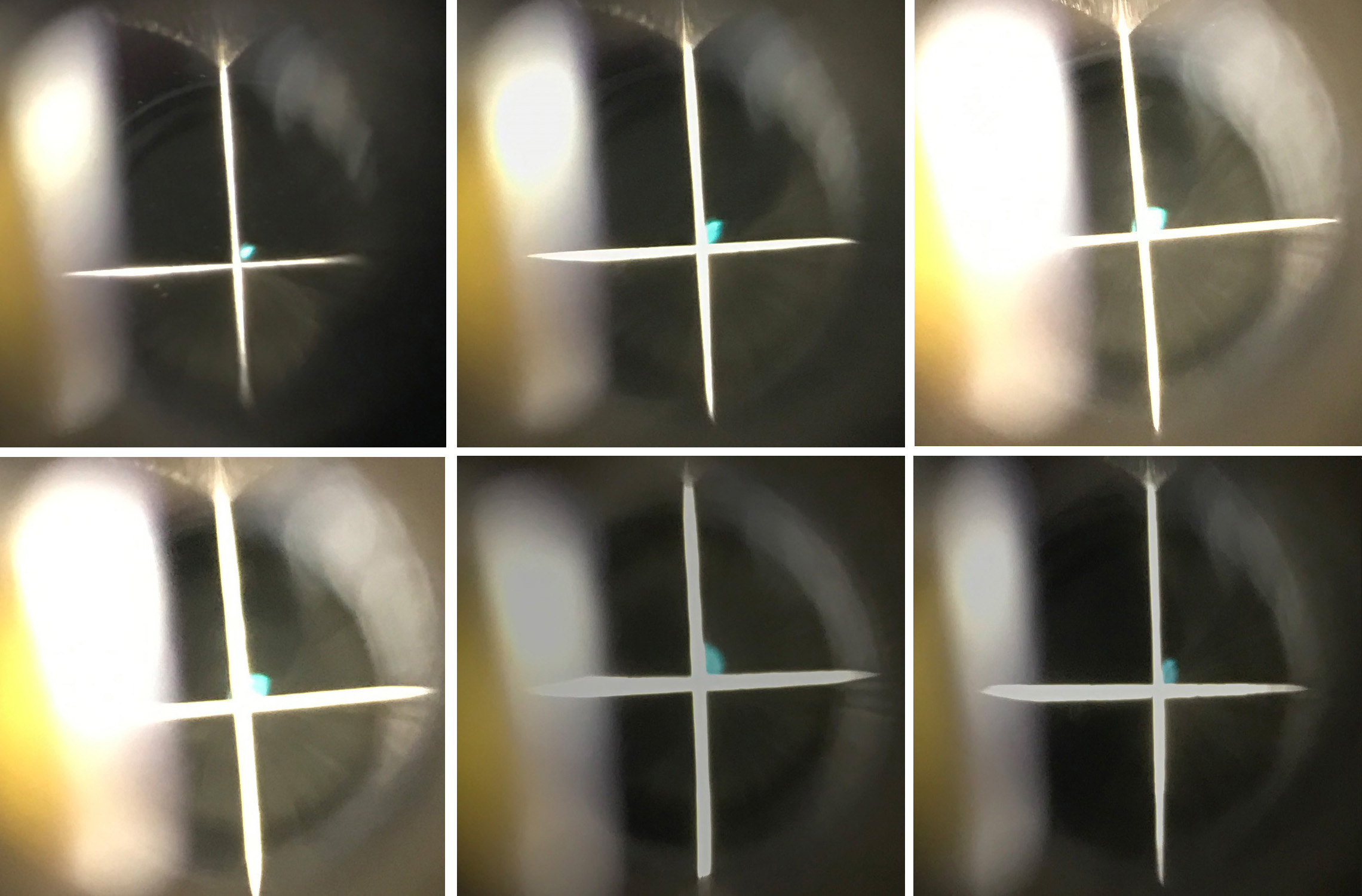
The 6061 turret result. The reflection pattern is tricky to focus on with a phone camera, but its position is captured at each of 6 positions.
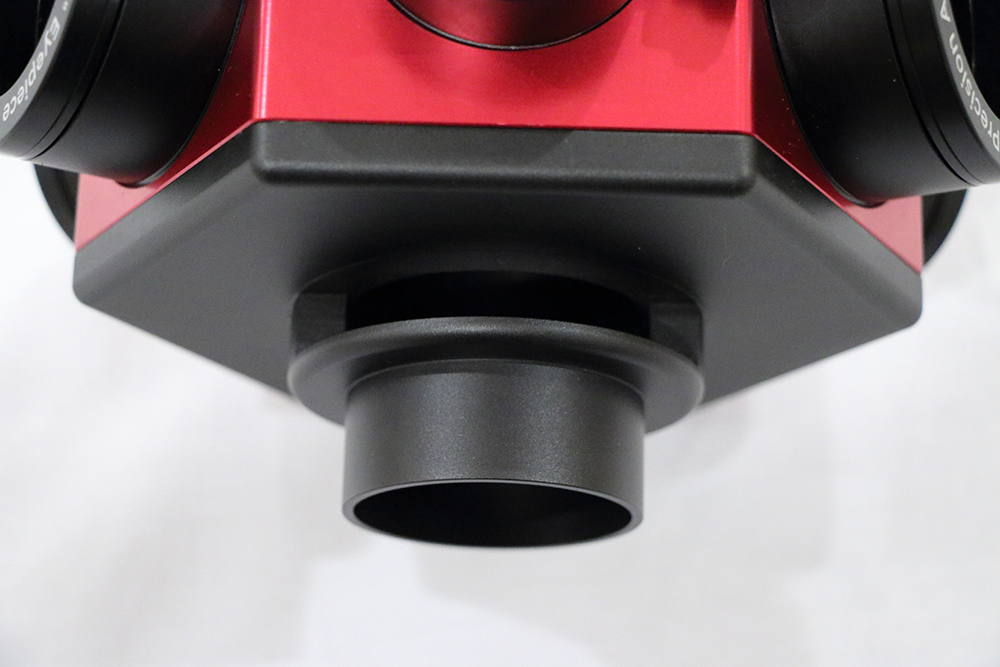
The filter slot allows for filters to be quickly dropped in and removed from the light path permitting use with all installed eyepieces.
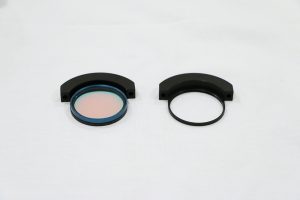
The filters use a M48x0.75 thread and can accommodate filters of up to 10mm thickness. Use an empty holder when no filter is needed to prevent stray light from entering.
Just behind the nose piece is a slot which allows a 2” filter to be dropped into the light path using the supplied filter holders, allowing your filters to be used quickly and easily with all your eyepieces and then rapidly switched out when moving onto a new object in the night sky. This is actually one of my favourite features of the turret and I actually purchased a filter holder for my SCT years ago which allowed a 2” filter to be simply dropped into the optical path. Not having to screw in the filters saves time, reduces risk of dropping equipment, and allows 2” filters to be used with both 1.25” and 2” eyepieces.
To confirm fabrication accuracy, a laser was used, reflected off a Thousand Oaks UHC filter which was dropped into the slot (a UHC has very narrow wavelength bandpass, so in effect acts like a mirror to most of the visible spectrum) and the return position of the laser was recorded. The test demonstrated the orthogonality of the slot. In addition, it was observed that the filter holders were held precisely so not to cut into the optical path. It should be noted however, that if the turret was rotated through 90 degrees, the filter holder would slightly slide out of position. This is not something that impacted me during testing as I only own Alt-Az mounts but could be an issue when using an equatorial. Speaking with nPAE, the latest versions of the turret will use magnets to secure the filter holder in place which should eliminate that problem.

Though a very short path length, the laser emerged back through the hole indicating the filter was being held orthogonal to the optical axis,
Setting up the Turret
The 6061 turret comes with a single page, double sided set of instructions, recommending that the first time the turret is set up it is done at home and not in the field at night. Given expensive eyepieces will find themselves hanging upside down, I cannot stress enough that familiarising yourself with the turret operation before use under the stars is of paramount importance.
Using a distant object, nPAE suggest inserting first your most used eyepiece and using the gross focus of the telescope to bring the view into focus. Then by rotating the outer sleeve clockwise, the compression fitting grips the eyepiece which is then locked into place by tightening down the thumbscrew. The next step is to rotate the second Maia lock into position and insert another eyepiece. Using only the focus wheel on the Maia lock, bring the next EP into focus and then lock it into position by twisting the sleeve and tightening the thumbscrew. This process is repeated for all six positions. I however, disagree slightly with the set-up process. The first time I used the turret I found after bring three eyepieces into the correct position that the fourth required more in-focus which could not be accommodated by the focus wheel (nPAE recommends in the instructions to go back to previously focused eyepieces and move the gross focus to a halfway point and then use the inbuilt focus wheels to adjust each eyepiece) and I found myself constantly having to adjust each previously set eyepiece, becoming a bit frustrated.
I decided to determine which of my eyepieces required the most in-focus, with that one set first before moving on to the rest, all of which could then be focused using the Maia focus wheels. I did find one or two eyepieces during my time testing the turret required an out-focus position of more than 10mm provided by the Maia locks which necessitated modest use of the gross focus of the scope. Also be aware that the individual focus wheels can completely unscrew from the Maia lock so keep an eye on it as you adjust during set up.
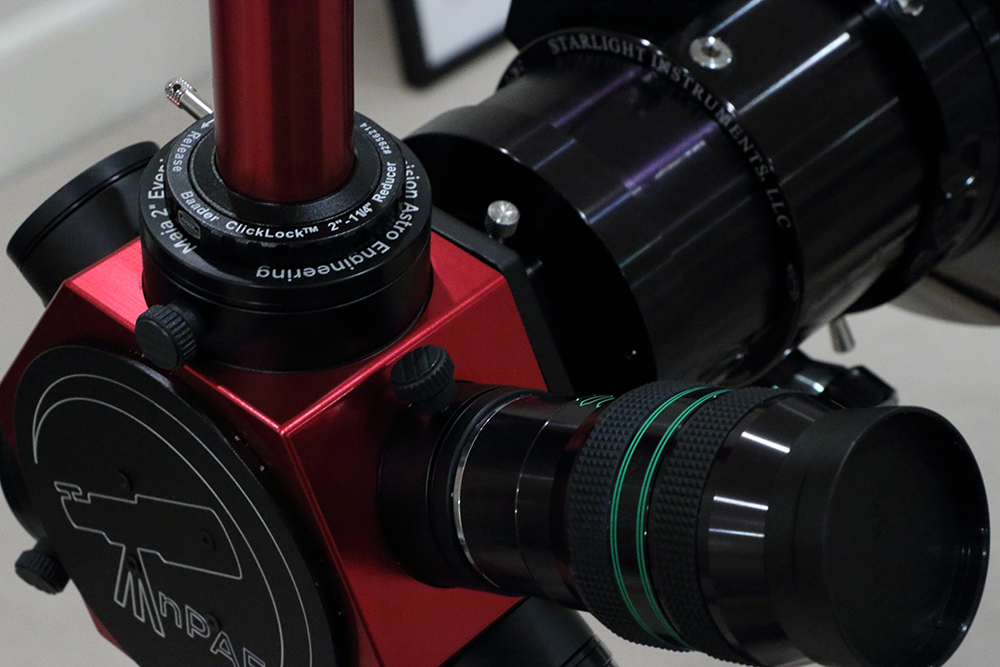
Though unrealistic here as EPs are only on one side and the other locks are empty, it demonstrates the unit can be pulled off-axis so try to arrange your EPs so provide an approximate even distribution of weight.
Once each Maia focus position is set, they can then be left where they are such that as long the same accessories are used next time you observe, and you remember which eyepiece goes in which lock, set up takes just a few minutes.
One other observation I made during my time with the 6061 turret is some consideration should be given to the weight of each eyepiece to make sure that there is a fairly even distribution of weight around the turret. If all the heavy eyepieces are on one side and opposite are some small light EPs, the imbalance can cause the turret to “torque” which shifts the resting position of the Maia lock away from the optical axis. In the accompanying picture above to demonstrate this, I loaded two heavy eyepieces on one side (4.5mm Delos and 17mm Nagler Type 4) and nothing on the other side. You can see the turret position is pulled with the magnets being insufficient to hold against that extreme amount of weight (compare that to the photo earlier in the review which shows a balanced resting position). The offset is also shown in the image taken through the Cheshire EP. This is obviously an extreme and unrealistic demonstration but provides evidence one should balance the eyepieces to maximise the performance when observing.
Under the Night Sky
In my opinion, any additional convenience offered by quickly switching between eyepieces will be completely negated if there is any reduction in performance at the eyepiece relative to fixed star diagonal. As with the bench testing, all comparison tests were made with my Tele Vue Everbright 2” diagonal which has served me well for many years under the stars. All night-time tests were made with my APM LZOS 180mm f/7 triplet, the APM LZOS 115mm f/7 triplet and my C11 f/10 SCT. All were mounted in an Alt-Az configuration.
To confirm the quality of the diagonal mirror, several factors were assessed including scatter around bright objects, perceived contrast in the image, colour rendition, limiting magnitude and vignetting, each compared to the Everbright diagonal.
A number of factors affect light scatter seen around bright objects in the night sky including atmospheric conditions (particulates and moisture in the air), as well as the optical components of an observing system including the primary aperture elements (lenses, mirrors and corrector plates), as well as reflections from internal surfaces in the OTA, any diagonals employed, and the lens elements in an eyepiece.
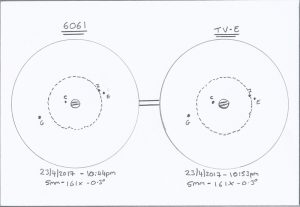
While incredibly similar, the extent of the scatter pattern appeared slightly less in the 6061 turret.
This test was delayed until a visit to a dark sky site so light pollution would not hide any differences in the scatter pattern. Jupiter was used and the extent of the scatter was estimated in relation to the position of the Galilean moons. To minimise any changes in atmospheric conditions, the comparison was conducted with the same telescope (LZOS 115), and used the same eyepiece (Nagler 3-6mm Zoom on the 5mm setting for 161x / 0.31o), just a few minutes apart, switching out the turret for the Everbright diagonal and rebalancing the scope.
As can be seen the accompanying sketch made at the eyepiece there was virtually nothing in it, with perhaps the turret just shaving it, but the difference was so marginal that minor changes in atmospheric conditions may have contributed to any perceived variation in scatter pattern.
Additionally, a couple of tight double stars were viewed including Propus in Gemini, and any differences in the ability to split them was noted. The star was split using the 6mm (134x) setting of the Nagler zoom with both the turret and Everbright. There was a tiny sliver of sky between the components, perhaps appearing a touch darker with the turret, but it was so marginal I was unable to convince myself it was real.
To asses any differences in image brightness, several open clusters in the winter sky were used with an estimate made of the dimmest stars visible in the field. This was then compared to the same view using the Tele Vue diagonal. I also made some comparisons with some emission and planetary nebula to see if the extent of the nebula increased or if low contrast features were easier to spot. In both tests, no discernible difference was noted.
Colour rendition was assessed primarily with some well-known colourful stars such as Alberio, T Cancri and Mu Canis Majoris. Star colours were shown equally well by both mirrors, always a captivating sight in the eyepiece. Subtle hues seen on planetary surfaces were also equally well seen with both diagonal mirrors.
A comparison of planetary detail seen in the eyepiece is difficult given atmospheric conditions from one moment to the next can have a major impact on the sharpness of the view and the time to switch from the 6061 to diagonal was a couple of minutes due to adjusting balance and utilising the same eyepiece. However, on Jupiter, both showed a wealth of subtle planetary detail including dark storms, festoons, multiple cloud bands and the GRS leaving me a satisfied observer regardless of which unit I was using.
To confirm that the dimensions of the mirror were sufficient to produce a fully illuminated field, the double cluster was allowed to drift from one side of the field stop to the other using the widest field eyepiece I currently have available, the Panoptic 35mm (2.96o field with the 115mm refractor), while carefully watching the brightness of the cluster. No dimming was seen in the periphery of the field indicated an appropriately sized diagonal.
All these comparison tests suggest that the mirror is of a high quality, matching the performance of known quality diagonal, crucially meaning that nothing is being given up at the eyepiece end of the scope.
Winter 2016/17 and Spring in the UK was rather mild which meant there were few opportunities to test the unit at temperatures below freezing. In fact, I only used the turret once when the thermometers were showing particularly frigid temperatures, with a low that night of -3oC. I did not note any detrimental performance characteristics under such conditions. The rotational movement was still smooth and no slippage was seen in the Maia locks. Thermal equilibrium did take longer to achieve than a regular 2” star diagonal, but this was perhaps 50% more in time which in reality meant a few extra minutes.
One concern I did have, especially in the cold damp UK was dew forming on the eye lens of the eyepieces as they would be exposed to the elements for an entire observing session, whereas under normal use, all but one EP would be snug in an eyepiece case. As mentioned this past winter was dry and mild so I never really encountered dew issues. Only on one night was I concerned it might be a problem, and rather than risk the session being cut short, I just kept each eyepiece capped when I was not using it, keeping the cap of the one in the observing position in my pocket, ready to replace before rotating to the next. It took little time and prevented any dew forming on the eyepieces.
Weight and Balance
The 6061 turret is a substantial piece of kit. Even more so when six eyepieces are connected to it. As such, strain on the focuser and balance issues must be considered. While many astro-photographers hang just as much weight off the back of a scope with cooled CCD cameras and filter wheels, many standard equipment focusers are likely to struggle under a load that can tip the scales at more than 6kg so reflect on whether a focuser upgrade might be needed if you are considering purchasing the turret.
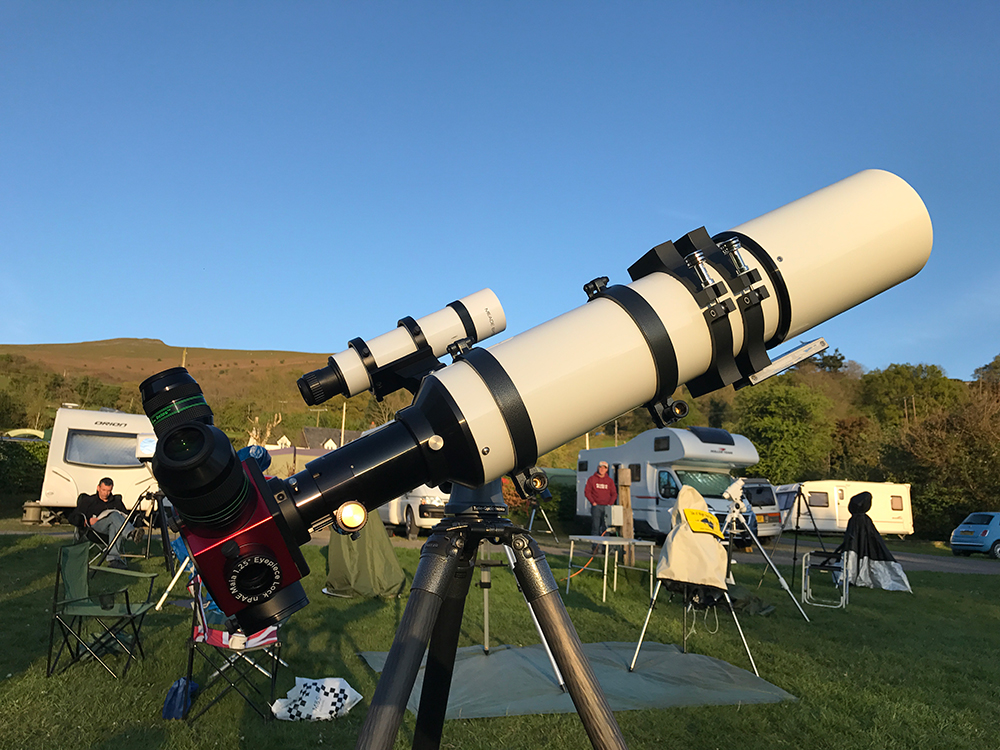
The turret was really too large for the 4.5″ triplet, requiring extra weight at the front to balance, but I required dark skies for some of the mirror testing and did not want to transport the 180mm refractor to the Astrocamp in the Brecon Beacons.
The team at nPAE suggest that the minimum aperture scope for use with the 6061 is seven inches and I tend to agree. When I used it with my LZOS 115mm triplet, I only used three eyepieces and found balancing the scope quite tricky, using additional tube rings and dovetails at the lens end of the scope to achieve balance.
My APM LZOS 180mm triplet is rather front heavy with the balance point of the barebones OTA only a few centimetres behind the lens cell. There are a couple of consequences to this. Viewing near the zenith can mean ending up on your knees due to a low eyepiece height. As such I really appreciate being able to hang extra weight off the back end of the scope and have purchased mount extension tubes, magnetic counterweights and an 80mm finder to shift the eyepiece height and the turret arrangement only adds to this. Secondly, because the scope is also long, there is a large moment of inertia which manifests when I replace a heavy 2” eyepiece with a small, lightweight 1.25” eyepiece. Historically this has meant either shifting the entire scope in its rings or more recently, sliding a weight along a rail on the side of the scope. Even the extremely heavy duty APM AZMaxLoad mount (you can read the review of the mount here) is sensitive to this and it eats into observing time, continually making these adjustments. Being set up at the beginning of observing session and not having to deal with this is something I really appreciated while using the turret.
Continued use under the stars
Once all the testing was out of the way, I kept using the turret each time I observed, and I really started to enjoy having the turret as part of my setup. Perhaps it really suits my observing style which sees me jumping all around the sky, switching eyepieces often, but just being able to switch eyepieces in a matter of seconds really added something to the observing experience. In particular, it really came into its own during high power observations of the planets. Seeing conditions in the UK typically are not the best, often restricting observers to powers of 150-200x at the most, but every so often, the stars align (so to speak), and the atmosphere really settles down which permits magnifications to be ramped up. Normally, the time taken to switch eyepieces means the window of tranquility passes an observer by, but being able to alter the power in mere seconds means you are always ready to benefit. I typically kept one very short focal length eyepiece in the turret ready to go at a moment’s notice and because of it, I have had some of the best planetary views ever from the UK.
When the time came to cease using the turret, I actually felt my heart sink the first time I went to switch eyepieces. Perhaps it had made me a little lazy, but the first thought that passed through my mind was do I really need to swap? It actually stopped me in my tracks. This was the moment when I realised that not only did the turret really compliment my style of observing, but I actually missed it as well.
The Fear Factor
I own a lot of expensive eyepieces. The Tele Vue 21mm Ethos cost over £600 when I purchased it and the thought of it crashing to the ground in the dark, possibly rendering it unusable is not an outcome I really wanted to entertain. In that regard, I have a confession to make. The first time I used the turret, I placed a bean bag chair under it in the hope it would provide a soft landing for any eyepiece that slipped the grasp of the Maia lock when hanging upside down. Fortunately, the bean bag was never called into action and after a first successful session, my trust grew in the unit.
My experience with the 6061 shows that one must not rush the set up. Take your time, make sure that each eyepiece lock is fully twisted and the thumbscrew is tightened down and you should have no problems. When taking some of the studio photos for this review, I did actually hurry through the set up and I failed to fully engage one of the locks, only to see a 17mm Nagler Type 4 slip slightly. Fortuitously, the safety undercut did its job and the Nagler did not fall to the ground. It was entirely my fault and then reinserting and making sure it was fully tightened saw no further problems. Take your time, trust in the Maia locks and you, like I did, will overcome your fear of hanging an eyepiece upside down.
Conclusion
It is probably clear from the review that I rather like the 6061 Medium Eyepiece Turret. After some initial trepidation about hanging expensive eyepieces upside down and some scepticism about the accuracy of the rotation mechanism, which all my testing demonstrated were unfounded concerns thanks to some thoughtful design and good engineering, I found it really complimented my observing style, was a pleasure to use, and offered additional benefits with my long and heavy scopes.
It is crucial to familiarise yourself with the unit before using in the observing field and to take your time when setting up to avoid any nasty accidents. The use of this unit with six eyepieces will result in far more weight hanging off the back of the scope than most visual astronomers normally ask of their focuser, so balance and quality of focuser do need to be considered.
The turret is quite expensive, costing more than many would spend on a telescope, but if you find yourself considering the 6061, you probably already own some pricey equipment. I am hopeful to move from my central London home to a more rural location in the next 12 to 18 months, and with that move comes the intention to build an observatory for my 180mm triplet. When I do, I expect I will add the nPAE medium turret to my permanent observing set up.






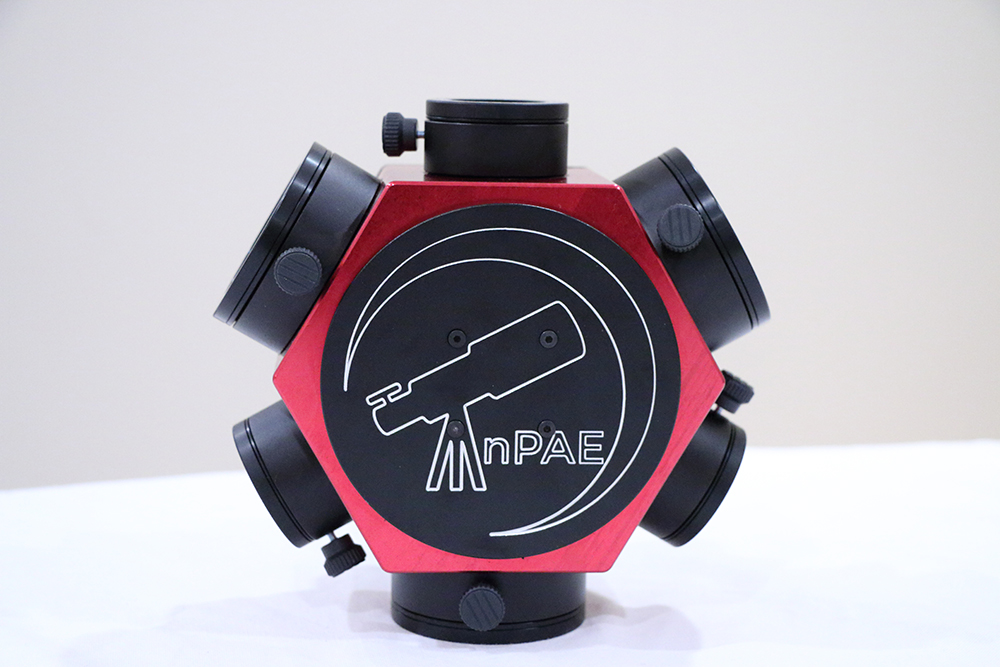

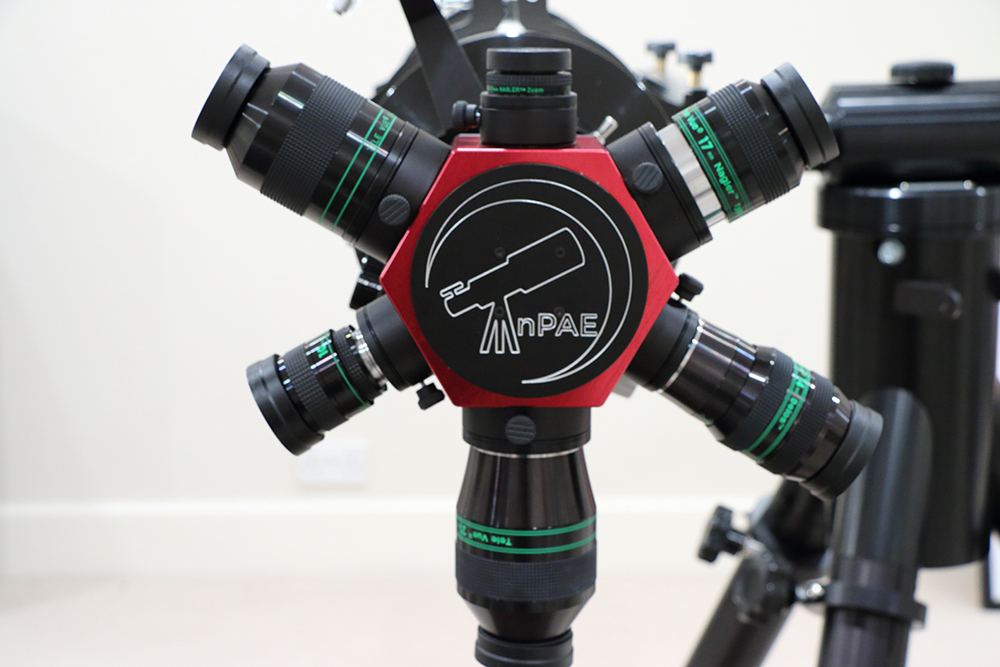
Pingback: Alpha-Lyrae Turret review – nPAE – Nottingham Precision Astro Engineering
Pingback: nPAE Theia90 Collimating Diagonal and Filter Changer Review | Alpha Lyrae